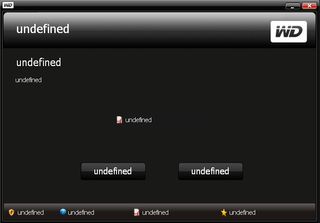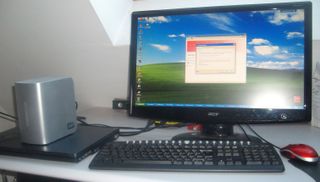Hard Disk Crash Survival Kit
Millions of drives crash every year. Family photos, personal diaries, and home videos are lost forever—or are they? Here’s what you can do before and after disks go bad.
My Book Studio II: A Mammoth System for the Occasion
You might think that 2 TB is almost overkill for home backups. However, the 2 TB of capacity that Western Digital’s My Book Studio II offers might only be adequate, especially if your home has multiple PCs (I have an embarrassing number in my house) and/or you have a large collection of video and music files.
The My Book Studio, which retails for about $200, offers RAID storage capabilities and can be set to RAID 1. With RAID 1, the data is mirrored on two disks, so if one goes bad, the same data is on the other disk. However, your backup capacity is cut in half, since instead of having 2 TB of capacity, there are copies of your data on two separate 1 TB drives.
You can also opt for RAID 0, so a single mirror of your data is stored on both drives, thus boosting performance (I doubt if you’ll notice) and doubling capacity. But as this writer has experienced, single-disk external hard drives do crash, so I would say that RAID 1 should be mandatory. If one of the My Book Studio disks fails, you can replace it with a new one.
Before plugging in the device and connecting it to my PC, I followed the user’s manual instructions by installing the software first on my Windows XP machine. The following screen then popped up:

I learned after doing a bit of Googling that other users could not get Windows XP to recognize the software as well. Without access to the drivers, my PC would not even recognize the device. I managed to work around the issue by typing compmgmt.msc in Windows’ Run prompt and partitioning the drives with the Windows Disk Management tool. However, I could not set up RAID 1, which I wanted to do, but other than that, my PC then recognized the drive.
The Western Digital software worked fine on another PC with Windows Vista. Backing up my Vista machine was then as easy to do as it was with the Data Deposit Box and Paragon alternatives. You are prompted to select the backup destination, the data to be backed up, and a name, and you are good to go. I managed to transfer about 1.5 GB of data per minute with the USB connection. Upon completion, the software allows you to later copy the backed files to another PC or external drive.
The My Book Studio II’s square compact shape allows it to discretely sit on or behind a desk. It also shuts itself off when not in use after a certain amount of time, which is a plus for power savings.
Sign up to get the BEST of Tom's Guide direct to your inbox.
Get instant access to breaking news, the hottest reviews, great deals and helpful tips.

Besides the Windows XP software mishap, the My Book Studio II’s performance and capabilities convinced me that $200 is a fair price to pay for two 1.0 TB disks in RAID 1 in a box available from a well established vendor. Placing the future of your data’s survival in the care of this device is worth the extra cash you might have saved by otherwise spending a lot less on a no-name external drive that would cause much misery if and when it crashes (more on that below).
Current page: My Book Studio II: A Mammoth System for the Occasion
Prev Page Paragon Backup and Recovery 10 Suite: The Ghost Option Next Page Crashed Disk? No Backup? No Worries (For a Price)-
FYI, many external HDDs are coming with built-in disk encryption, which would make the "recovery facilities" impotent at restoring your lost data. If your drive(s) has this "feature," you may have to ensure your data is recoverable if the case/drive has issues. (yes, some solutions, WD has one, requires the external drive enclosure to read the encrypted data from the HDD)Reply
-
longshotthe1st Please do something about the spam or I am outta here, as well as others I'm sure.Reply -
Scanlia Yeah, there are spammers everywhere and the +1/-1 system doesn't seem to be working... DO SOMETHING TOM!!!Reply -
rdhood This is an extremely simplistic article.Reply
There are *many* partition/disk imaging packages available, often for free (Acronis, Paragon and Easeus come to mind, they offer old additions for free on a regular basis), and 1TB drives are now $60! You can regularly back up your entire drive to a bootable hard disk. Have a drive crash? Swap disks and boot. Downtime is about one minute.
If you have two computers, it is a good idea to back up data from one system to another.
When 1TB drives are $60, there is no good reason not to have a full image backup. -
ctmk For desktops, What about software disk mirroring in Windows 7?Reply
It "seems reliable" on my case. even i unplug one of the drive and plug it in another Windows XP machine and the Dynamic Disk can still be recognized and mounted. Performance were good and no extra hardware required.
-
Darkk I personally like CrashPlan as it offers multiple ways of backing up your data to including offsite either for free (buddy) or for a fee at the data center.Reply
I use the native disk image backup in Windows 7 which is set to backup at least once a week. CrashPlan is always backing up every 15 minutes of any file changes. Very handy to recover a file that have been accidently overwritten.
-
Any linux live cd!Reply
A friends mac book pro died before xmas and Apple couldn't recover the data (their recommendation was new hdd - unit was still under warranty).
Booted from Linux mint and recovered about 95% of his work and family files (other 5% were on broken part of disk). I'm no expert but it was pretty easy to do and after some file permission issues were sorted was as simple as drag and drop the files to a usb drive -
stokesj75 I would have like to seen applications like photorec and testdisk (both Linux applications) covered in this article . These allow for recovering from minor hard drive corruption or crash. as long as it is just bad blocks/sectors, missing partitions , deleted files and folders.Reply
